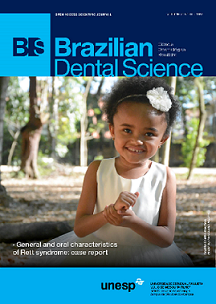TMJ dimensions in three-dimensional virtual models acquired through computed tomography of cone beam as sexual dimorphism
DOI:
https://doi.org/10.14295/bds.2017.v20i3.1425Abstract
Objective: The objective of this study was to relate the dimensions of the mandibular condyle with sex and age by means of three-dimensional models obtained by cone-beam computed tomography images (CBCT). Material and Methods: 120 CBCT examinations were selected belonging to the archives of the ICT-UNESP Clinic of Radiology. They were divided into five age groups, each containing 12 individuals of each sex. Virtual three-dimensional models were then created and two measurements from each mandibular condyle were taken: anteroposterior (AP) and mediolateral (ML). The t-test was used for independent samples to compare the measurements. Results: The AP measurements only of the left side showed a statistical difference between the sexes between 31 to 40 years of age; in the ML measurements, there were statistical differences between the sexes in all age groups on both sides, except in the age group above 60 years. Conclusion: The ML measurements of the mandibular condyles, regardless of side, showed significant statistical differences between sexes and age groups, with a tendency to greater values in males, and may be a determinant factor of sexual dimorphism.
Keywords
X-Ray computed Tomography; Radiology; Sexual characteristics; Forensic anthropology; Forensic dentistry.
Downloads
Downloads
Published
How to Cite
Issue
Section
License
Brazilian Dental Science uses the Creative Commons (CC-BY 4.0) license, thus preserving the integrity of articles in an open access environment. The journal allows the author to retain publishing rights without restrictions.
=================




























